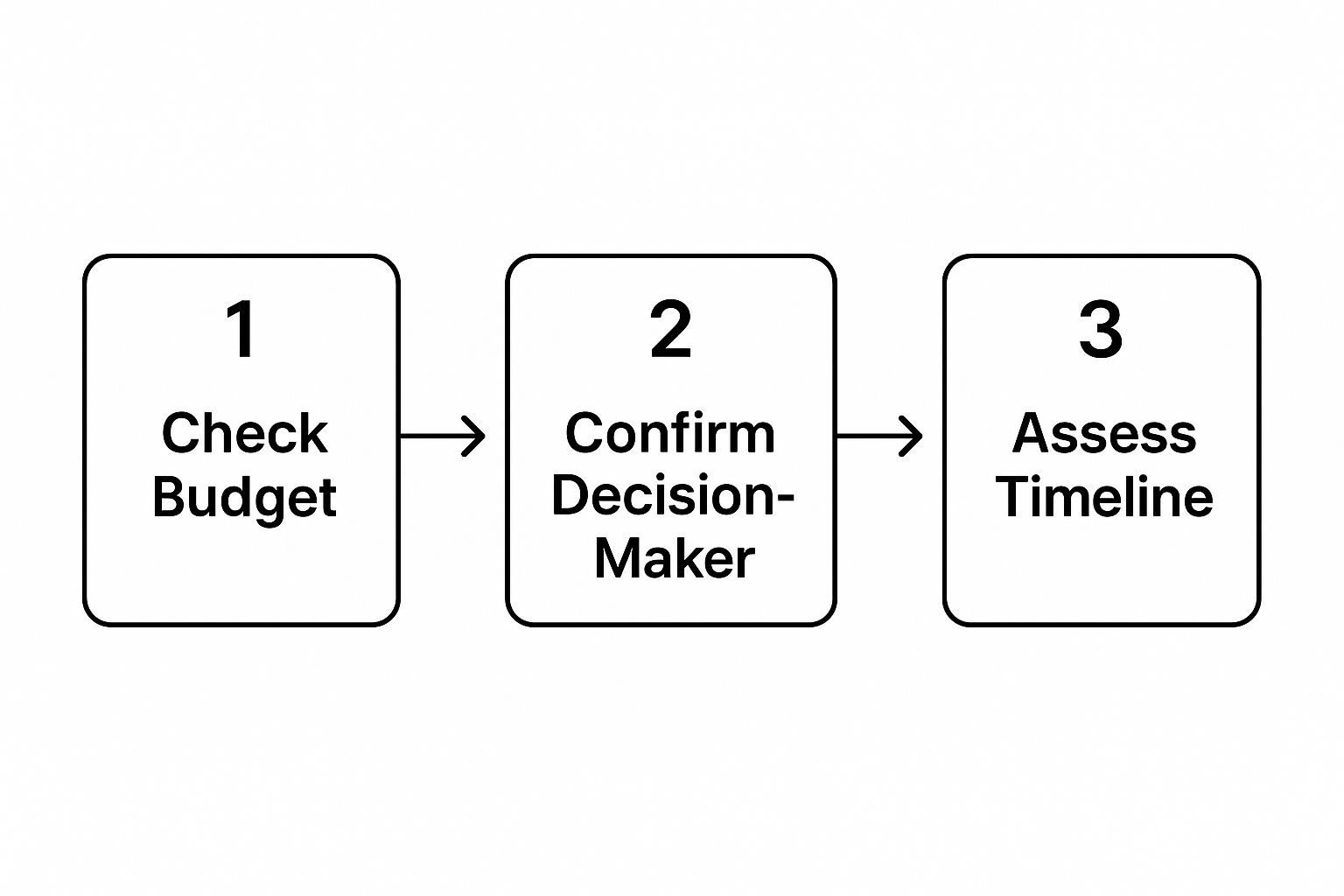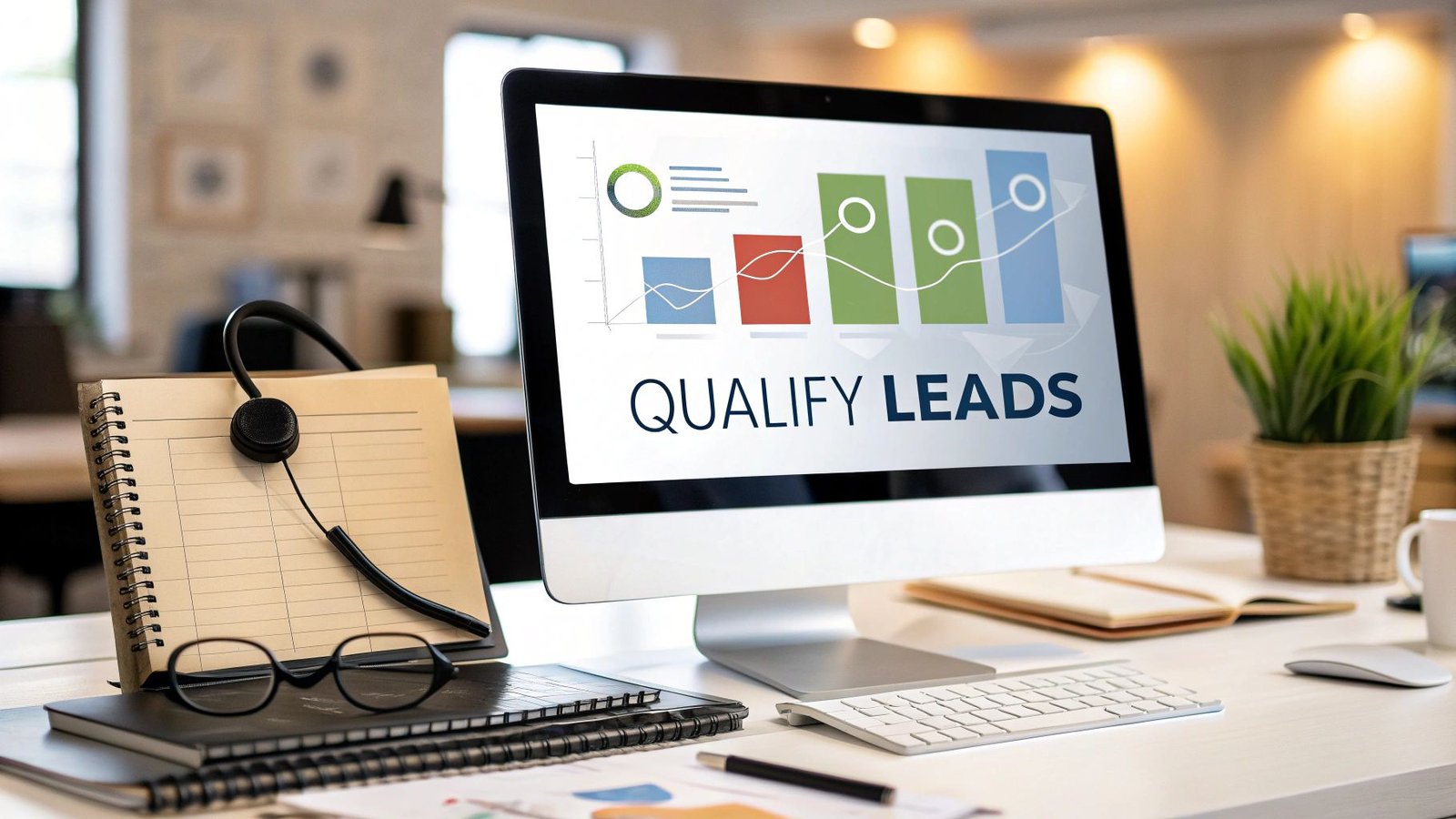Qualifying a sales lead is all about figuring out who's just browsing and who's a serious buyer. It’s the essential step of filtering your prospect list to concentrate on those who actually have the need, the budget, and the authority to make a purchase. This way, your sales team can pour their energy into conversations that actually lead somewhere.
Why Chasing Bad Leads Is Costing You Deals
Let's get real for a moment. Most lost sales don't happen because of a clumsy pitch. They happen because we were chasing the wrong person from the very beginning. When your pipeline is jammed with unqualified leads, you’re doing more than just wasting time—you're actively losing money and killing your momentum.
The Hidden Costs of Poor Qualification
Think about it: every hour a sales rep spends on a lead that was never going to convert is an hour they could have spent building a relationship with a future customer. This is where the real damage happens.
- Wasted Time and Effort: Your team gets caught in a loop of follow-up emails and calls with people who were never a good fit.
- Plummeting Team Morale: Facing constant rejection from mismatched prospects is a surefire way to burn out your best people.
- Inaccurate Forecasting: A pipeline full of fluff gives you a false sense of security and almost always leads to missed revenue targets.
The numbers are pretty stark. A staggering 67% of lost sales are a direct result of sales reps failing to properly qualify leads. That’s two-thirds of your potential revenue disappearing before a meaningful conversation even has a chance to start. You can dive deeper into these critical sales statistics to see just how common these pitfalls are.
Qualification isn't just another box to check. It's the most important filter you have. It shifts the focus from just collecting contacts to strategically identifying your ideal future customers.
By putting a solid qualification process in place, you turn your sales efforts from a frantic numbers game into a smart, precision-driven strategy.
Defining Your Ideal Customer Profile
Let's start with the absolute foundation of qualifying sales leads: you can't find the right people if you don't know who you're looking for. This is where a rock-solid Ideal Customer Profile (ICP) comes in. Think of it as the blueprint for your perfect customer, the benchmark against which you’ll measure every single lead that comes your way.
A genuinely useful ICP goes way beyond surface-level details like company size or industry. You need to dig into the specifics that truly signal a perfect fit. What are the granular details that separate a good customer from a great one?

This means getting into the nitty-gritty of their business—their financials, the tech they use, and even what’s happening inside their company right now. For example, a SaaS startup I know targets companies with 50-200 employees that recently hired a VP of Sales and use HubSpot as their CRM. That specific combination points to a company that's scaling, has a clear need, and is technologically compatible. It’s a bullseye.
The Key Ingredients of a Powerful ICP
To build a profile that actually works for you, focus on the attributes that you’ve seen lead to success with your existing customers. An established enterprise software vendor, for instance, might laser-focus on companies with over $100 million in revenue that are actively divesting a business unit. That’s a massive trigger event.
Your whole mission here is to find the common threads that tie your best, most profitable customers together. Here’s what I recommend breaking it down into:
- Firmographics: Get the basics down. What’s their annual revenue, employee count, and geographic footprint?
- Technographics: What’s their tech stack really look like? Pinpoint the specific CRM, ERP, or marketing automation tools they rely on daily.
- Behavioral Triggers: What’s happening right now? Did they just land a new funding round, expand into Europe, or post job openings for key leadership roles? These are buying signals.
To help you get started, here's a quick way to think through the different layers of your ICP.
ICP Criteria Breakdown
| Category | Definition | Example Question to Ask |
|---|---|---|
| Firmographics | The basic, quantifiable characteristics of a company. | What is their annual revenue and number of employees? |
| Technographics | The technologies and software a company uses. | Which CRM or marketing automation platform are they on? |
| Behavioral | Recent events or actions that signal a need or opportunity. | Have they recently received funding or hired new executives? |
| Pain Points | The specific challenges or problems your product solves. | Are they struggling with inefficient manual processes? |
Putting this all together gives you a multi-dimensional view of your ideal customer, moving far beyond simple demographics.
Your ICP is the bedrock of your entire sales qualification process. It makes sure you’re not just chasing any lead, but actively attracting prospects who have the potential to become your best, long-term partners.
Once you have this profile dialed in, it sharpens everything you do, from your marketing campaigns to your outbound sales cadence. It focuses your team’s precious energy where it will make the biggest difference.
Of course, defining who to target is just the first step. You can dive deeper into the next phase in our guide on how to generate leads for your pipeline.
Choosing the Right Qualification Framework
Okay, so you've nailed down your Ideal Customer Profile. You know exactly who you should be talking to. Now, the real question is how do you talk to them? This is where a solid qualification framework comes into play, giving your sales reps a reliable playbook for those crucial discovery calls.
Let's be clear: a framework isn't a script. No one wants to be interrogated. Think of it as a guide—a compass that helps your team ask the right questions at the right time, all while keeping the conversation flowing naturally. It’s about making sure every call is strategic and uncovers what you really need to know to spot a genuine opportunity.

The idea is to get past the surface-level questions. You want to spark a real dialogue that gets to the heart of a prospect’s challenges, motivations, and ability to buy.
Matching the Framework to Your Sales Cycle
There's no single "best" framework. The right one for you depends entirely on the complexity of your sales process. A high-volume team selling a simple SaaS product needs something very different from a team navigating a complex, six-figure enterprise deal with a dozen stakeholders.
-
BANT (Budget, Authority, Need, Timeline): This is the old classic for a reason. It’s direct, efficient, and perfect for shorter, more transactional sales cycles. When your reps are handling a high volume of leads, BANT helps them quickly filter out the noise and focus on the real contenders.
-
MEDDIC (Metrics, Economic Buyer, Decision Criteria, Decision Process, Identify Pain, Champion): Selling big-ticket items to large companies? MEDDIC is your gold standard. It forces a much deeper discovery process, making reps dig into the internal politics, the specific business metrics, and the entire decision-making food chain. It’s a lot more work, but it's essential for navigating those long, complex deals.
You might also hear about CHAMP, which is essentially BANT reordered to start with Challenges. It’s a small tweak, but leading with a prospect's pain points can make the conversation feel more customer-focused right from the start.
From Framework to Conversation
The magic happens when your reps can turn these acronyms into genuine, human conversations. It’s not about ticking boxes on a list. It’s about weaving these concepts into the discussion.
A great discovery call feels less like an interrogation and more like a consultation. The rep’s job is to diagnose the prospect's situation, and a good framework is simply the tool they use to guide that diagnosis effectively.
For example, instead of the clunky "What's your budget?" a BANT-trained rep might ask, "To get a sense of scope, what have you typically invested in solutions to tackle this kind of challenge before?" It gets you the same information but opens the door to a much richer conversation.
For more ideas on how to kick off these discussions, check out our guide on outbound lead generation. Giving your team these kinds of conversational tactics is what transforms a simple framework into a seriously powerful sales tool.
Building a Practical Lead Scoring Model
So, you've defined what a good lead looks like for your business. That's a huge step. But now the real challenge begins: who do you call first? Not every qualified prospect is ready to buy today, and a solid lead scoring model is your secret weapon for making sure your team is spending its time on the right conversations.
Think of it as a system that assigns points to leads based on who they are and what they do. This gives you a clear, data-driven way to surface the hottest opportunities. It’s about moving beyond gut feelings and letting a lead’s own actions tell you how serious they are.
This graphic gives a great overview of the core qualification checks that should feed into any good scoring model.

Each of these points—from budget and authority to need and timeline—can be turned into a score. It’s what helps you instantly tell the difference between someone just browsing and a buyer who’s ready to make a decision.
Explicit vs. Implicit Data: What They Tell You vs. What They Do
A truly effective lead scoring model doesn't just look at one side of the story. It balances two critical types of information: what a lead tells you about themselves, and what their actions show you.
-
Explicit Data: This is the straightforward information they hand over. Think firmographic details like company size, industry, job title, and location. If a lead’s profile perfectly matches your Ideal Customer Profile, they get a healthy dose of points.
-
Implicit Data: This is all about behavior—the digital body language. It's what you observe them doing on your website, with your emails, or during a webinar. Did they visit your pricing page? Download a technical whitepaper? These actions are powerful signals of buying intent.
Let’s put it into practice. A Director of Sales (explicit) from a 100-person tech company (explicit) who visits your pricing page three times in a week (implicit) is a much hotter lead than a marketing intern who only downloaded an introductory ebook. Your scoring model absolutely has to reflect that difference.
A lead's behavior is often a more reliable indicator of intent than their title. Pay close attention to actions that signal a prospect is actively evaluating solutions, not just gathering information.
This focus on user action is exactly why Product Qualified Leads (PQLs) have become so important. These are prospects who have already used your product, typically through a free trial or a freemium version. Their in-app behavior speaks volumes.
It’s no surprise, then, that 46.4% of businesses now consider PQLs their most qualified lead segment, blowing past traditional Marketing Qualified Leads (MQLs). You can dig deeper into these emerging lead generation trends to see where the market is heading.
Ultimately, your scoring system creates a simple threshold. Once a lead’s score crosses a certain number—let's say 100 points—they are automatically flagged as a Sales Qualified Lead (SQL). That's the trigger to get them over to a sales rep for immediate, personalized follow-up.
Using Speed to Your Advantage

The moment your scoring system flags a hot lead, a timer starts. It's an invisible race, and every second counts. A perfectly qualified prospect can go from "very interested" to "who were you again?" in a matter of minutes, which is why your team's response time is one of the most powerful levers you can pull.
This isn't just a gut feeling; the data is crystal clear on this. Studies consistently show that if a sales rep can get back to a new lead in under five minutes, their odds of actually qualifying them jump by a staggering 10 times.
Wait just a bit longer—say, 10 minutes—and you're looking at a 400% drop in your chances. You can see more of the hard numbers behind this in these crucial lead generation stats. The takeaway is simple: speed wins.
Making Every Second Count
Hitting that golden five-minute window consistently isn't about telling your reps to "work faster." It's about building a system that's engineered for speed from the ground up. This is where you bring in smart automation and clear internal handoffs to make sure hot leads get immediate attention.
So, how do you do it?
-
Set up automated lead routing. Configure your CRM to instantly assign a high-scoring lead to the next available rep. This simple step cuts out the manual bottleneck of a manager having to divvy up leads, which can take hours.
-
Use chatbots and instant alerts. A well-placed chatbot on your site can engage visitors, ask a few qualifying questions, and instantly alert the sales team via Slack or email the moment someone looks promising.
One of the best things you can do is establish a formal Service Level Agreement (SLA) between your marketing and sales departments. This document isn't just paperwork; it’s a commitment. It should spell out exactly what a "qualified lead" is and lock in a maximum response time, creating shared accountability.
This blend of technology and process closes the gap where so many valuable leads get lost—that limbo between marketing generating the lead and sales taking action. If you're looking for more ways to find these high-value opportunities in the first place, our guide on prospecting for leads is a great place to start.
By making speed a core part of your strategy, you give every promising lead the immediate attention it deserves, dramatically improving your chances of converting that flicker of interest into a signed contract.
Common Questions About Qualifying Sales Leads
Even with a great system on paper, you'll always run into a few hurdles when you start qualifying leads in the real world. Let’s walk through a few of the most common questions and challenges that pop up for sales teams.
What’s the Real Difference Between an MQL and an SQL?
This is a classic, and the distinction is crucial for keeping your sales and marketing teams aligned.
A Marketing Qualified Lead (MQL) is someone who's shown interest in what you do, but they’re not ready for a sales call just yet. Maybe they downloaded an e-book or attended a webinar. They're curious, but still kicking the tires.
A Sales Qualified Lead (SQL), however, is a whole different ballgame. This is someone the sales team has actually spoken with and confirmed is a good fit. They meet your Ideal Customer Profile criteria, they have a real problem you can solve, and they're actively looking for a solution. It’s all about their readiness to buy.
How Do I Qualify Leads Without Sounding Like I’m Reading From a Script?
Nobody likes feeling like they're being put through an interrogation. The secret is to shift your mindset from a checklist-filler to a consultant.
Instead of hitting them with a blunt "What's your budget?", try a more conversational approach. You could ask something like, "Have you folks set aside a budget for this kind of project, or is that something you're still exploring?"
This simple change frames the conversation as a collaborative discussion, making you a helpful advisor instead of just another salesperson trying to make a quota.
How Often Should We Update Our Lead Qualification Criteria?
Your lead qualification criteria can't be a "set it and forget it" kind of thing. Your market shifts, your product gets new features, and your competitors change their strategies.
A good rule of thumb is to sit down with your team and review your ICP and lead scoring rules at least twice a year.
The absolute best insights for tweaking your criteria will come from digging into your closed-won and closed-lost deals. Look for the patterns. This data tells the unfiltered story of what a genuinely great lead looks like for your business right now.
Ready to stop guessing and start targeting the right decision-makers? The Nordic Lead Database gives you access to the most extensive database of companies and contacts in the Nordics. Find your ideal customers and fill your pipeline with high-quality, pre-vetted leads. Start building your perfect prospect list today.
